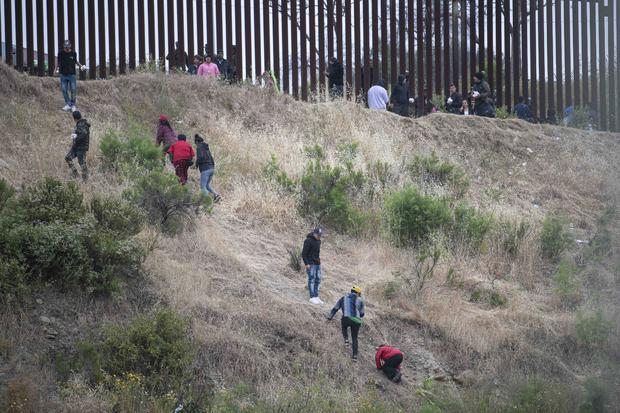Washington — In just a few months, the U.S. received more than 1.5 million requests from individuals hoping to sponsor the entry of migrants from four countries, an extraordinary number that could jeopardize the Biden administration’s objective of reducing border crossings, internal documents obtained by CBS News show.
The flurry of hundreds of thousands of sponsorship applications on behalf of would-be migrants from Cuba, Haiti, Nicaragua and Venezuela has overwhelmed caseworkers at the U.S. Citizenship and Immigration Services (USCIS), which can approve no more than 30,000 arrivals under the program each month.
American citizens, residents and others in the U.S. with a legal immigration status are eligible to sponsor migrants from these four countries, as long as they agree to financially support them. Migrants who arrive under the program are granted two-year work permits under the humanitarian parole authority.
Due to the massive and rapidly mounting backlog of unresolved applications, USCIS recently altered the way it processes these cases, selecting half of the requests it reviews each month through a lottery system. The other half will continue to be adjudicated on a first come, first serve basis.
The internal Department of Homeland Security documents obtained by CBS News indicated that as of the end of last month, the agency was receiving an average of nearly 12,000 applications per day from those seeking to sponsor Cubans, Haitians, Nicaraguans and Venezuelans, calling the number “overwhelming.” The documents noted that less than three days’ worth of applications were processed per month due to the 30,000 monthly cap.
More than 100,000 migrants have arrived in the U.S. under the sponsorship initiative. But the government was overseeing more than 580,000 pending cases for Haitians, more than 380,000 for Cubans, nearly 120,000 for Venezuelans and more than 20,000 for Nicaraguans at the end of April. Other cases were being reviewed or had been approved.
A version of the program was first launched in October 2022 to allow Venezuelans with U.S.-based sponsors to fly to the U.S. directly, as part of an effort to reduce what at the time were record arrivals of Venezuelan migrants along the southern border. In January, the initiative was expanded to include Cubans, Haitians and Nicaraguans, who also journeyed to the U.S.-Mexico border in record numbers last year.
Jon Putman/SOPA Images/LightRocket via Getty Images
The sponsor program has been paired with a policy of returning Cubans, Haitians, Nicaraguans and Venezuelans who cross the southern border illegally to Mexico, which agreed to take back these nationalities, first under the now-expired Title 42 public health order and now under regular U.S. immigration law.
The combination of returns to Mexico with the sponsorship program has led to a sharp drop in illegal border crossings by migrants from these four crisis-stricken countries, whose governments won’t or can’t accept large numbers of U.S. deportations due to diplomatic or operational reasons.
Top White House officials have boasted about the strategy’s success. But the soaring number of applications for the sponsorship program, far above its 30,000 monthly cap, threatens to derail the policy’s main objective: encouraging would-be migrants to refrain from crossing the southern border illegally by offering them a meaningful chance to enter the U.S. legally.
The internal DHS documents say the hundreds of thousands of pending cases have caused “significant” wait times for applicants. If the monthly cap is not raised, the documents acknowledged, the program’s effectiveness could diminish.
“The migrants who are desperate, and they’re desperate migrants, will wait only so long before they say ‘it’s not happening and I’ll take my chances getting something else,’ whether that’s entering clandestinely or just show up at the border and see if they can be let in,” said Theresa Cardinal Brown, a former DHS official and current immigration analyst at the Bipartisan Policy Center, a Washington think tank.
Top U.S. officials have not indicated that they will raise the 30,000 monthly cap on admissions. Representatives for DHS did not answer several questions about the program, including on whether the ceiling would be altered.
In April 2022, the Biden administration launched its first version of the sponsorship policy, setting up a program dubbed Uniting for Ukraine to allow Americans to sponsor Ukrainians fleeing the Russian invasion of their homeland. Unlike the subsequent sponsor program, Uniting for Ukraine has no numerical cap. As of earlier in May, 127,000 Ukrainians had come to the U.S. under the policy.
Changing the cap for the Cuban, Haitian, Nicaraguan and Venezuelan sponsorship initiative could have legal and foreign affairs implications.
The Biden administration and the Mexican government have tied the arrival of up to 30,000 migrants in the U.S. to Mexico’s commitment to accept the return of the same number of Cubans, Haitians, Nicaraguans and Venezuelans turned away by American border officials.
“Thirty thousand for 30,000 is something that has proven to work, and we’ve committed — both countries — to continue with that arrangement of 30,000 to 30,000 after May 11,” a senior U.S. official told reporters earlier this month.
The sponsorship policy is also being challenged in federal court by a coalition of Republican-led states that argue the Biden administration does not have the legal authority to use parole to admit up to 360,000 migrants each year outside of the regular visa system.
Blas Nuñez Neto, the top DHS official for border and immigration policy, said last week that Mexico was “unlikely” to continue accepting returns of Cubans, Haitians, Nicaraguans and Venezuelans if the sponsorship program was blocked in court.
Daily unlawful border crossings soared to a record high 10,000 earlier this month, just prior to the termination of the Title 42 public health restrictions on migration, but have since plummeted to 3,000 in recent days.
Biden officials have attributed the sharp drop in border crossings to increased formal deportations of those who enter the U.S. illegally and a restriction that disqualifies many migrants from asylum, as well as efforts by Mexican and Guatemalan military and law enforcement officials to slow U.S.-bound migration.

